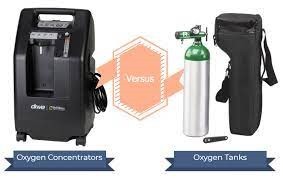Oxygen Concentrators Vs Oxygen Cylinders: As cases surge and with oxygen cylinders in short supply across several states, the oxygen concentrator is among the most sought-after devices for oxygen therapy, especially among patients in home isolation and for hospitals running out of oxygen.

Analysis
How does it work?
- An oxygen concentrator is a medical device that concentrates oxygen from ambient air.
- Atmospheric air has about 78 per cent nitrogen and 21 per cent oxygen, with other gases making up the remaining 1 per cent.
- The oxygen concentrator takes in this air, filters it through a sieve, releases the nitrogen back into the air, and works on the remaining oxygen.
- Concentrators are designed for continuous operation and can produce oxygen 24 hours a day, 7 days a week, for up to 5 years or more.
Suggested Article
Nitrogen Pollution Cause &Effect in India
At 90-95 per cent purity, is the oxygen from concentrators pure enough?
- While it is not as pure as Liquid Medical Oxygen (LMO) (99%), experts say it is good enough for mild and moderate Covid-19 patients with oxygen saturation levels of 85% or above. It is, however, not advisable for ICU patients.
- Concentrators can be attached with multiple tubes to serve two patients at the same time, but experts don’t recommend it since it carries risk of cross-infection.
How are concentrators different from oxygen cylinders and LMO?
- Oxygen concentrators are the easiest alternatives to cylinders but can only supply 5-10 litres of oxygen per minute (critical patients may need 40-50 litres per minute) and are best suited for moderately ill patients.
- Concentrators are portable and unlike LMO that needs to be stored and transported in cryogenic tankers, need no special temperature.
- And unlike cylinders that require refilling, concentrators only need a power source to draw in ambient air.
How do they compare with cylinders in terms of cost and maintenance?
- While at Rs 40,000-90,000 concentrators are more expensive than cylinders (Rs 8,000-20,000), it’s largely a one-time investment.
- Apart from electricity and routine maintenance, there’s little by way of operational cost, unlike cylinders that involve refilling costs and transportation.